Tuleyome's Policy Corner - What Does it Take to Add Molok Luyuk to Berryessa Snow Mountain National Monument?

Molok Luyuk with Snow Mountain the distance by Marc Hoshovsky
In today’s policy corner, I thought I’d take the opportunity to answer some questions that we’ve received regarding the steps necessary to add Molok Luyuk to Berryessa Snow Mountain National Monument, or to establish any National Monument.
Establishing a National Monument is first and foremost a community process. It is the best of democracy; people in a community or communities coming together with their neighbors and elected representatives to effect positive change.
There are two ways to establish a National Monument and protect objects of historic or scientific interest. Monuments can be established through a Presidential proclamation pursuant to the Antiquities Act of 1906, 16 USC 431-433, or through an Act of Congress, legislation. The vast majority of Monuments are established by Presidential proclamation.
The effort to protect Molok Luyuk’s public lands began with a coalition of folks including Tuleyome, the Yocha Dehe Wintun Nation, conservation and recreation groups, scientists, landowners and our champions in Congress who recognized Molok Luyuk’s significant cultural, geological and natural resource values.
Representatives Garamendi and Thompson, Senator Padilla and the late Senator Feinstein introduced The Berryessa Snow Mountain National Monument Expansion Act in two different sessions of Congress. The legislation would add Molok Luyuk (currently known as Walker Ridge) to Berryessa Snow Mountain National Monument, rename it Molok Luyuk (Patwin for Condor Ridge) and require Tribal co-management of the Monument.
Tuleyome and our partners built support for the bills’ passage. We’ve been on the ground in Lake and Colusa County communities that will benefit from the increased recreation and economic benefits that Monuments bring, going door to door to talk with folks about our efforts. We have met with our elected representatives and decision-makers —locally, in California and in DC. We have published articles and held lectures with experts throughout the area.
This is democracy in action.
This support led to the House bill passing off the floor of the House of Representatives and the Senate bill passing unanimously out of committee with the support of leadership of both parties. Unfortunately, the effort could not withstand forces opposed to expanding public lands in the House of Representatives and the bills have not become law.
So, we turned our efforts to obtaining a Presidential proclamation.
Of course, the best way to share the significance of a place is to share the actual place. I was honored to be able to participate in Secretary Haaland’s visit to Molok Luyuk in September of this year. I had the opportunity to speak directly with Secretary Haaland, BLM Director Stone-Manning, Representatives Garamendi and Thompson and Yocha Dehe Wintun Nation Secretary James Kinter about the uniqueness and importance of this place. Secretary Haaland also held a roundtable with Tribes and community leaders and took a hike with us on Frog Pond Trail.
We have continued our on-the-ground efforts in the Counties, hosted a dozen wildflower tours for decision-makers and the media and keep expanding our coalition. We now have dozens of businesses, local and neighboring landowners, local Tribes, a coalition of dozens of varied groups, and more than 87,000 individuals supporting the effort to protect Molok Luyuk.
So, what are the next steps?
The next step is a public listening session, where we get the opportunity to speak directly with the Bureau of Land Management (BLM) and U.S. Forest Service (USFS) officials and share why this place is important to us. At it, BLM and USFS will hear from Tribes, elected officials and the public.
It is our chance to show President Biden what we want for our communities. It is our chance to convince President Biden to protect Molok Luyuk, to issue a Presidential proclamation adding Molok Luyuk to Berryessa Snow Mountain National Monument.
It is democracy in action.
The question Tuleyome doesn’t get from our members is: What does adding Molok Luyuk to Berryessa Snow Mountain National Monument mean for me?
You already know.
- It gives you a say in its Management, in what is protected and how, a say in how and where we play with our friends and family.
- It brings recreation and economic opportunities to local communities.
- It allows Tribes to co-manage these public lands in partnership with BLM, drawing on thousands of years of knowledge of the land and its cycles and better protecting the places that we love.
- It means that your kids and their kids will also be able to enjoy and appreciate all that Molok Luyuk and Berryessa Snow Mountain National Monument offer.
Adding Molok Luyuk to Berryessa Snow Mountain National Monument means better stewardship of this place and its resources for all of us. After all, it is our public land.
So, if you haven’t already, join us in protecting Molok Luyuk for today and tomorrow.
Come to the Public Listening Session on December 13 from 2 - 4 pm at the Woodland Community and Senior Center and sign our petition.
-Sandra Schubert; sschubert@tuleyome.org
Executive Director
RECENT ARTICLES






